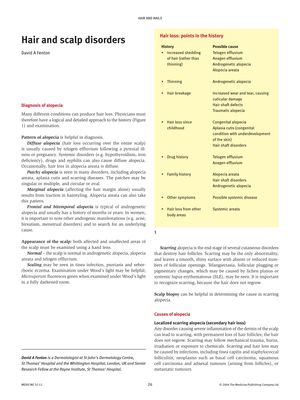Hair and Scalp Disorders
December 2004
in “
Medicine
”
alopecia telogen effluvium systemic disorders syphilis alopecia areata scarring alopecia discoid lupus erythematosus lichen planus androgenetic alopecia hypertrichosis hirsutism endocrine disorders anti-androgens seborrhoeic dermatitis Malassezia yeast antiyeast agents sebaceous naevus minoxidil Rogaine

TLDR Different hair and scalp disorders cause hair loss or excess hair growth, with various treatments available depending on the specific condition.
In December 2004, David A. Fenton provided an overview of hair and scalp disorders, emphasizing the diagnosis and prognosis of various forms of alopecia. Diffuse alopecia can be caused by telogen effluvium, systemic disorders, drugs, and syphilis, while patchy alopecia may be due to alopecia areata and scarring diseases. Androgenetic alopecia, common in both genders, leads to gradual thinning of hair. Scarring alopecia, caused by conditions like discoid lupus erythematosus and lichen planus, prevents hair regrowth. Alopecia areata, an autoimmune disorder, has a 75% chance of spontaneous hair regrowth in patchy cases, but extensive hair loss is likely to recur. Hypertrichosis, or excessive hair growth, can be congenital or acquired, with causes ranging from genetic disorders to systemic diseases, and drugs like minoxidil can induce hair growth. Hirsutism in women can be due to endocrine disorders or drugs, with management options including hair removal and anti-androgens. Seborrhoeic dermatitis is linked to Malassezia yeast and treated with antiyeast agents, while sebaceous naevus may require excision to prevent malignancy.


